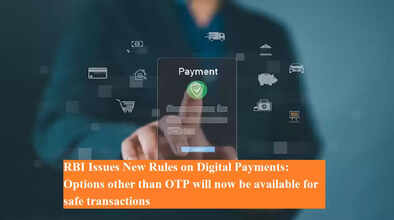RBI Issues New Rules on Digital Payments: Options other than OTP will now be available for safe transactions

RBI Issues New Rules on Digital Payments: OTP Not the Only Option for Safer Transactions from April 2026
The Reserve Bank of India (RBI) has announced new guidelines to enhance the security of digital payments in the country. While SMS-based OTP (One-Time Password) will continue to be in use, customers will soon get additional options for authenticating their transactions. The new rules, titled “Directions on Authentication Mechanisms for Digital Payment Transactions, 2025”, will come into effect from April 1, 2026.
India is among the countries that strongly emphasize two-factor authentication (2FA) to safeguard online payments. Until now, financial institutions have largely relied on SMS alerts and OTPs for transaction verification. However, the RBI has now expanded the framework, making it more flexible, secure, and future-ready.
What Will Change?
According to the RBI’s new notification, two-factor authentication can now be carried out using a wider range of tools beyond SMS OTP. These include:
-
Passwords or passphrases
-
PINs (Personal Identification Numbers)
-
Hardware or software tokens
-
Fingerprint scans
-
Other biometric identifiers
The RBI clarified that SMS OTP will remain available, but institutions must provide at least one more unique and dynamic authentication factor for each transaction. This ensures that if one factor is compromised, others remain secure.
Unique Authentication Factor Mandatory
Under the new rules, at least one authentication factor for every transaction must be unique and freshly generated. This could be a new OTP, a one-time biometric check, or any other mechanism that changes with each transaction.
The central bank emphasized that payment systems must be robust enough so that compromising one factor does not weaken the entire process. This layered approach aims to minimize fraud and ensure greater reliability in India’s rapidly growing digital payments ecosystem.
Risk-Based Authentication
The RBI has also allowed financial institutions to adopt risk-based evaluations for transactions. This means banks and payment companies can assess the risk level of a transaction using various indicators, such as:
-
The user’s location
-
Device details
-
Transaction history
-
Behavioral patterns
For high-risk transactions, additional authentication steps may be required. For example, if a user tries to make a transaction from an unusual location or device, the system may demand extra verification before processing it.
Furthermore, for confirmations and notifications, institutions may also use platforms like DigiLocker to strengthen reliability.
Compensation for Customers
In a consumer-friendly move, the RBI has made it clear that if any financial loss occurs due to non-compliance with these authentication guidelines, the issuing bank or institution will be required to fully compensate the affected customer.
This provision ensures accountability and encourages banks and payment companies to strictly implement the guidelines without lapses.
Additional Provisions for Card Transactions
Apart from domestic payments, the RBI has also focused on cross-border digital transactions. Starting October 1, 2026, card issuers must implement a validation mechanism for:
-
Non-recurring transactions
-
Cross-border, card-not-present (CNP) transactions made through overseas acquirers
This is expected to further curb fraud in international transactions, where risks are typically higher.
Why These Changes Matter
Digital payments in India have grown exponentially in recent years, driven by UPI, card payments, and mobile banking. With this rise, cases of online fraud and phishing have also become more sophisticated. The new RBI rules aim to strengthen trust in the system while offering flexibility and convenience to users.
By moving beyond the reliance on SMS OTP, India is aligning its payment security framework with global best practices. The introduction of multiple authentication methods and risk-based checks will help in building a safer, more resilient digital economy.
Key Takeaways
-
Effective Date: April 1, 2026
-
OTP Not Alone: SMS OTP to continue, but other options like biometrics, PINs, and tokens will be allowed
-
Unique Factor Required: At least one fresh authentication element per transaction
-
Risk Management: Institutions can flag and verify high-risk transactions based on location, device, and history
-
Customer Protection: Full compensation if loss occurs due to non-compliance
-
Global Transactions: Extra validation for overseas card-not-present payments from October 1, 2026
✅ With these reforms, the RBI has reinforced its commitment to keeping India’s digital payment ecosystem safe, secure, and future-ready, while giving customers more choice and assurance in how they verify their transactions.

